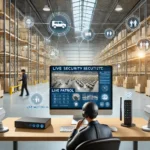Construction sites will inevitably involve the storage and ongoing use of high-value vehicles, materials, tools, and machinery. Effective lighting is one of the simplest, cheapest, and most impactful ways to enhance security and safety at construction sites. A well-lit construction site deters thieves and vandals and prevents accidents. According to a recent Aviva report, equipment theft in Canada amounts to nearly $46 million annually, with a significant portion occurring in Ontario alone.
Let’s take a look at some of the the security threats faced by construction sites, the importance of adequate lighting, recommended lighting systems for construction sites and parking garages, and how to prevent accidents and theft with live video monitoring and security cameras.
Importance of Lighting in Security Systems
Lighting plays a pivotal role in keeping construction sites secure for several reasons. Bright lights make it difficult for intruders to hide in dark areas, signaling that the site is under surveillance and deterring criminal activity. Well-lit areas allow security personnel to monitor key spots like entrances, fences, and storage areas effectively. Proper lighting also ensures the safety of security guards, minimizing shadows and reducing their visibility as targets.
Ensuring Sufficient Illumination
Adequate lighting is crucial for safety and security on construction sites. Clear, consistent lighting helps workers perform tasks accurately, reduces the risk of accidents, and makes it easier to identify potential hazards. Bright, steady lighting helps prevent intruders and vandals by eliminating hiding spots and facilitating site monitoring.
Uniform lighting distribution is essential to avoid areas of high contrast, which can cause visual discomfort and safety risks. Achieving uniform light distribution involves:
- Positioning light fixtures to minimize shadows.
- Using lighting that provides consistent brightness across the site.
- Ensuring light beams overlap slightly to eliminate dark spots.
Managing Glare and Light Trespass
Controlling glare is essential to prevent discomfort and accidents on construction sites. Proper placement of lights to minimize direct exposure to workers’ eyes, using diffusers or frosted lenses to soften light, and installing adjustable lights can significantly reduce glare and harsh shadows.
Emergency Lighting
Emergency lighting is vital during power outages or emergencies, ensuring safe evacuation and effective emergency response. Key considerations include having a reliable backup power source, positioning lights to illuminate exit routes clearly, and regularly testing and maintaining emergency lighting systems.
Recommended Light Fixtures for Job Sites
Choosing the right light fixtures is essential for adequate illumination on construction sites. Here are some recommended options:
Light Towers
Portable light towers, often running on generators, provide temporary lighting in outdoor or remote areas. These towers can be set up with one large light or several smaller ones to evenly illuminate the area, ensuring visibility and safety.
High Mast Lights
High mast lights are tall fixtures that extend work hours by providing even illumination in large areas. Often using energy-saving LEDs, these lights reduce shadows and improve visibility. However, they can be expensive and challenging to maintain due to their height and location.
Balloon Lights
Balloon lights offer soft, diffused light without glare, creating a comfortable and safe work environment. They are compact, easy to move, and can be used independently or attached to construction equipment. Balloon lights are flexible and can be adjusted to illuminate specific areas.
Equipment-Mounted Lights
Equipment-mounted lights improve visibility and safety by directing light toward the work area. These lights are stable and aligned, especially in low-light conditions, though they only work when the equipment is on and might not cover all stationary work areas.
Security Systems on Job Sites
Physical security measures and security systems protect construction sites from theft, vandalism, and unauthorized access. Key components of an effective security system include:
Alarm Systems
Alarm systems are the first line of defense against intruders, alerting security personnel to breaches. Motion detection sensors placed at vulnerable entry points trigger alarms, providing early warnings. Audible alarms scare off intruders, while silent alarms discreetly notify security personnel, increasing the chances of apprehending intruders.
Surveillance Cameras
Surveillance cameras monitor construction sites before, during, and after work hours. Placing cameras at entry and exit points, storage areas, and high-risk zones enhances site security. Choosing high-resolution, night-vision cameras and ensuring secure video footage storage are crucial for effective monitoring and incident investigation.
Access Control Systems
Access control systems manage who can enter and exit the job site, enhancing security and accountability. Key components include:
- Key fobs and cards for authorized entry.
- Access credentials connected to a cloud-based system for real-time monitoring.
- Biometric systems for higher security levels.
- Detailed entry logs to track site access and restrict sensitive areas.
Integrating Lighting with Security Systems
Integrating lighting with security systems enhances safety and security. Smart lighting systems synchronized with security cameras and sensors provide additional protection.
Surveillance Cameras
Pairing motion-activated lights with surveillance cameras illuminates areas when movement is detected, deterring intruders and improving camera performance. Infrared lighting is effective for night-time surveillance.
Access Control Systems
Bright lights at gates and entry points help security personnel verify credentials and identify individuals entering the site. Well-lit keycard scanners and biometric readers improve usability and accuracy.
Alarm Systems
Connecting lights to alarm systems provides immediate visual cues when an alarm is triggered, helping security personnel locate and address breaches quickly. Flashing lights can also signal a breach, useful in noisy environments.
Reducing Theft and Injuries with Construction Site Lighting
Proper lighting reduces the risk of theft, injuries, and vandalism. It helps workers avoid accidents, such as tripping over equipment, and identify potential hazards. Well-lit areas deter intruders, improve surveillance, enhance visibility, highlight hazards, facilitate night operations, and aid emergency responders.
Regulatory Standards and Codes for Lighting and Security Systems
Ensuring optimal illumination levels is essential for a safe and productive construction site. In Canada, the Occupational Health and Safety Guidelines mandate a minimum lighting level of 55 lux (5-foot candles) for safe work execution. Recommended lighting levels, according to WorkSafeNB, suggest a minimum of 10-foot candles (100 lux) for general construction areas.
Enhancing Job Site Security with Surveillance Cameras and Live Video Monitoring
Surveillance cameras are a crucial element of construction site security. They monitor activities before, during, and after work hours, providing a constant watch over the site. To maximize their effectiveness, it’s essential to position cameras strategically at entry and exit points, areas where tools and materials are stored, and high-risk zones with expensive machinery. High-resolution cameras capable of capturing clear images, even at night, are vital for identifying intruders and investigating incidents.
However, even the best cameras and optimal lighting are insufficient without real-time monitoring. This is where live video monitoring services come into play. Live monitoring ensures that there are eyes on the site at all times, ready to respond to any suspicious activity. Here’s how these elements work together to enhance job site security:
Strategic Placement of Surveillance Cameras
Proper placement of cameras enhances their ability to capture critical footage. Cameras should cover:
- Entry and Exit Points: Monitoring entrances and exits helps track who comes and goes, preventing unauthorized access.
- Storage Areas: Keeping an eye on places where valuable tools and materials are stored deters theft and allows for quick response if theft occurs.
- High-Risk Zones: Areas with expensive machinery or high-value materials are prime targets for thieves. Monitoring these zones ensures they are protected.
The Role of Lighting in Surveillance
Lighting and surveillance cameras must work together to create an effective security system. Adequate lighting ensures cameras can capture clear footage. This is particularly important in low-light conditions or at night. Motion-activated lights can illuminate areas when movement is detected, providing clear visuals for the cameras and deterring potential intruders.
- Motion-Activated Lighting: These lights turn on when they detect movement, illuminating the area and allowing cameras to capture better images. This not only deters intruders but also alerts security personnel to potential breaches.
- Infrared Lighting: For night-time surveillance, infrared (IR) lighting can be used with night-vision cameras. IR lights are invisible to the naked eye but provide necessary illumination for cameras to capture clear images in the dark.
The Importance of Live Video Monitoring
Live video monitoring services add a critical layer of security to construction sites. While cameras and lights are vital, having trained security personnel watching the footage in real-time ensures a quick and effective response to any incidents.
- Real-Time Response: Live monitoring services can quickly identify and respond to suspicious activities. Whether it’s an intruder trying to gain access or a worker in need of help, live monitoring ensures immediate action.
- Deterrence and Evidence Collection: The presence of live monitoring acts as a deterrent to potential thieves or vandals. Knowing that someone is watching can prevent crimes before they happen. Additionally, recorded footage provides valuable evidence in the event of an incident, aiding investigations and potentially leading to the apprehension of criminals.
Integrating Lighting with Surveillance and Monitoring
Integrating lighting with surveillance cameras and live video monitoring services creates a comprehensive security system. Here’s how:
- Alarm-Triggered Lighting: Connecting lights to alarm systems means that when an alarm is triggered, the area is immediately illuminated. This helps security personnel and cameras get a clear view of the situation.
- Surveillance Synchronization: Smart lighting systems synchronized with surveillance cameras ensure that cameras always have adequate lighting to capture clear footage.
Improve Construction Site Security with Live Video Monitoring and Security CamerasLive Patrol
Live Patrol’s remote live video monitoring services, powered by AI technology, offer 24/7 surveillance, detecting and responding to irregularities in real time. Our services include strategic camera placement, advanced AI capabilities for differentiating between people and vehicles, and swift response protocols, ensuring your site remains secure around the clock. Additionally, our remote concierge services and access control management provide comprehensive solutions for managing site access and enhancing overall security.
Live Patrol goes beyond traditional security by offering time-lapse video services to capture project progress and drive digital engagement. Our next-gen technology reduces costs, delivers fast response times, and provides detailed monthly reports to highlight security improvements. With 24/7 monitoring accessible via smartphone app and desktop software, you stay connected to your site at all times. Enhance your construction site’s security, safety, and efficiency with Live Patrol. For more information, contact us at 416-477-3350 or info@livepatrol.com. Advanced security solutions made simple, protecting your site and ensuring peace of mind.


